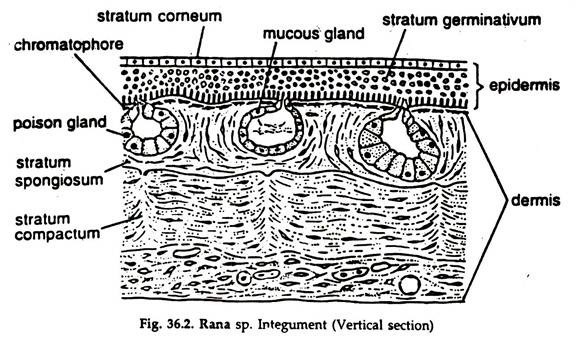In this article we will discuss about the external anatomy of a frog, explained with the help of suitable diagrams.
The body is divisible into two parts—the posterior, short and stout trunk and the anterior, broad, depressed head:
There is no neck between the head and the trunk. Tail is absent (Fig. 36.1). Two pairs of limbs, one at the anterior and another at the posterior end of the trunk, are present. The skin is rough and greyish in colour and large number of warts are present on the skin of the dorsal surface.
Two elevated ridges are present on the two sides of the head and posterior to these ridges on the dorsal surface of the anterior end of the trunk, two elevated longitudinal glandular structures, the parotid glands, are present. In general, the toad is very ugly.
Head:
The head is more or less triangular with a nearly semicircular anterior border, drawn into a blunt snout. The mouth is large and situated slightly ventral to the snout. The opening of the mouth is transverse, bounded by two jaws and extends on the sides behind the eyes. Two small apertures, the nostrils, one on each side, are present on the dorsal surface of the snout.
The nostrils open into the buccal cavity and the internal openings are known as internal nares. The eyes are rounded, large, prominent and located on each side of the head.
Each eye is protected by an immovable thick fold of skin on the upper surface, the upper eyelid; a movable lower eyelid and in continuation with the latter is a semitransparent, thin, membranous nictitating membrane, which can be drawn over the eyes. The nictitating membrane is also known as the third eye-lid. Just behind and close to each eye a circular area of stretched skin—the tympanic membrane — is present.
ADVERTISEMENTS:
Trunk:
Two pairs of limbs of unequal size are present on two ends of the trunk. The anterior pair is known as forelimb. The forelimb is short and consists of an upper arm or brachium, a forearm or anti-brachium and a hand. The hand is divisible into three parts—the wrist (carpus) or the portion next to the forearm, the palm (manus) or the broad middle portion and the digits or fingers.
The digits are short, tapering, four in number and directed forwards. During breeding season, the cushion-like thumb pads are well- developed at the basal part of two fingers (inner finger of each forelimb) in male.
The posterior pair of limbs, the hind limbs are much larger in size. Each hind-limb consists of a thigh or femur, a shank or crus and a foot. The foot is divisible into three parts—an ankle (tarsus) or the portion next to the shank, the instep (pes) or the middle portion and the digits or toes.
ADVERTISEMENTS:
The digits are five in number, long and directed forward and united by thin folds of skin, webs. The cloacal aperture is situated at the posterior end of the trunk. The faeces, urine and the products of reproductive organs come out through this aperture. Sexual differences (dimorphism) is present. The male is provided with a vocal sac on the ventral surface of the buccal cavity, in addition to thumb pads.
Skin:
The skin is water-tight, an adaptation to prevent dehydration or loss of water by evaporation, a characteristic of all land tetrapod’s. The skin consists of two layers (Fig. 36.2) outer epidermis and inner dermis.
Epidermis:
The epidermis consists of several layers of cells. The outermost layer, stratum corneum is thin, scaly and made of dead, cornified cells. During ecdysis the cornified layer is shed in fragments. The deeper layers of cells constituting stratum germinativum of the epidermis consists of columnar cells with prominent nucleus.
Dermis:
The dermis is composed of two layers— an outer loose layer, stratum spongiosum and an inner, more compact layer, stratum campactum. The outer part of stratum spongiosum is more compact than the rest. Blood vessels, lymph spaces, nerves and glands are abundant in stratum spongiosum.
Unusually large number of blood vessels help the skin to serve as an important structure for respiration. The glands are of two types—mucous glands and poison glands, present in the region of warts.
ADVERTISEMENTS:
The stratum compactum is composed of dense connective tissue, smooth muscle fibres, nerves and blood vessels. Chromatophores or pigment cells present, for the most part, between the epidermis and dermis, brings about change of colour of the integument to blend with the surroundings.

